Abstract
The separation of walnut kernels from shells is a crucial step in walnut processing. Pneumatic sorting is the mainstream method. However, due to the overlapping suspension speeds of half-shells and eighth-shells, complete separation was not achieved. This paper proposes using a toothed vibrating screen to separate the two. Using EDEM to simulate and analyze the motion forms, collision processes, and stress conditions of walnut shells and kernels on the vibrating screen, the effectiveness of this method was demonstrated, and the mechanisms of shell–kernel retention and loss during the separation process were revealed. Results indicate that 1/8 kernels, being smaller, easily fall into tooth grooves and move upward step by step under the excitation force during reciprocating vibration. The 1/2 shells, being larger, are difficult to fall into the teeth grooves, and their smooth surfaces cause them to slide easily, moving downward continuously under the action of reciprocating vibration and gravity. Using the cleaning rate and loss rate as evaluation indicators, it was found that as the inclination angle of the vibrating screen increased step by step, the cleaning rate consistently increased monotonously. The loss rate initially rose slowly, then surged sharply after reaching 22°, at which point the loss rate was at its lowest, around 10%, and the cleaning rate was at its maximum, at 95%. The shortest retention time of walnut shells on the screen is 2.85 s, and the longest is 10.6 s, with the number of collisions being 458 and 2619, respectively; the collisions between the shells and the kernels account for 51.8%. The failure to thoroughly separate is due to the shell and kernel entangling within the separation area, making it impossible to segregate them. They enter the opposite region, collide, and cause loss and retention phenomena.
1. Introduction
With the continuous increase in walnut planting scale and yield, mechanization of the walnut industry has become an inevitable path. The airflow separation method is currently the main method for shell–kernel separation [1,2,3]. However, due to the overlap in the suspension speeds of 1/2 shell and 1/8 kernel, as shown in Table 1 for the suspension speeds of different components after walnut cracking [4], it is impossible to achieve thorough separation of the shell–kernel mixture using pneumatic separation [5,6]. This not only leads to a significant loss of walnut value but also poses obstacles to the subsequent processing of walnut products. Therefore, achieving the separation of 1/2 shell and 1/8 kernel is key to solving this problem. From the perspective of materials, the geometric differences between 1/2 shell and 1/8 kernel are most significant [7]. Based on this, this study proposes using a toothed groove vibrating screen to achieve the separation of 1/2 shell and 1/8 kernel. Preliminary results demonstrate that this method can effectively achieve the separation of the two, although phenomena of shell retention and kernel loss persist. Revealing the mechanism behind these phenomena is crucial to resolving this issue. Such understanding is of great significance for promoting the full mechanization of the walnut industry.

Table 1.
Suspension velocities of walnut shell kernel mixture components.
The tooth groove vibrating screen is a type of vibrating screen, whose principle is similar to the shaking board in grain combines [8,9,10]. It is mainly aimed at working conditions where there are significant differences in geometric dimensions and surface friction coefficients between mixtures. Its structure is simple and has good stability, making it widely used in many fields. Therefore, to optimize its screening effect, scholars have conducted research from different perspectives. For example, Wang et al. [11] started from the critical situation of material movement on the fish scale screen, and obtained the critical conditions for different movement directions by taking the single-particle material as the research object. Based on this, the working parameters were optimized, providing a reference for the design of related models. Fu et al. [12] theoretically analyzed the movement of the shaking board in the grain combine and obtained the relationship between the material throw-off conditions and the crank speed, providing a theoretical basis for related research. Tang et al. [13] compared the screening performance of single-partition and double-partition shaking boards through EDEM software simulation and found that the double-partition shaking board has an advantage in material uniformity. Li et al. [14] designed a double-layer air screen device that improves rice cleaning efficiency by adjusting the wind speed (4–8 m/s), but its effect is limited for particle systems with a density difference of less than 1.2 times. For multi-layer screening separation structures, although they show good results in the cleaning process of crops such as corn [15], tiger nut [16], sunflower [17], their multi-stage vibration characteristics can significantly increase the collision frequency between walnut kernels and the screen surface, making it easy for the walnut kernels’ outer skin to become damaged. Without the protective outer skin, walnut kernels are more prone to oxidation, which greatly increases storage difficulties and severely affects product quality. In the aspect of walnut shell and kernel material separation, despite the overlap in the suspension speed range of 1/2 shell and 1/8 kernel, some scholars have attempted to achieve separation through multi-stage air separation chamber design [18]. This method ignores the problem of geometric heterogeneity, as the flake shape of the shell (aspect ratio > 3) and the polyhedral structure of the kernel lead to deviations in the calculation of the aerodynamic drag coefficient. The traditional spherical particle model cannot accurately describe its suspension posture. Moreover, instantaneous agglomeration caused by shell–kernel collisions—for instance, the formation of a “shell–kernel-shell” sandwich—can substantially alter the local wind field distribution. Therefore, it can be seen that the problem cannot be solved by suspension speed. The vibrating screening technology achieves stratification through the collision of particles with the screen surface. Its core lies in the matching of the screen surface motion trajectory and the particle contact characteristics. Existing research can be divided into two categories: regular particle research and irregular particle research. For instance, Zhang et al. [19], in their EDEM simulation of goji berry screening, demonstrated that simplifying the berries into regular spheres, combined with a synergistic effect between amplitude (3–5 mm) and frequency (15–25 Hz), can enhance screening efficiency; Liu et al. [20] simplified rice particles into rotationally symmetric ellipsoid particles using EDEM, and based on this, optimized the vibration frequency, amplitude, vibration direction angle, and screen plate inclination angle, helping to improve rice cleaning; Gao et al. [21] designed a cylindrical cam vibrating screen to process corn mixtures, reducing clogging through tooth structure optimization, and the particle model was modeled in a way close to the original material shape, helping corn cleaning. Feng et al. [22] made three kinds of irregular corn models and used EDEM to fill them, studying the movement of particles during the screening process using these models, and analyzed the screening mechanism. Summarizing the above research, it can be found that scholars have made certain breakthroughs in vibrating screening, whether for regular or irregular particles, and have improved the cleanliness and screening efficiency of corresponding materials. However, most are based on screening and cleaning. When using screening, due to the wide particle size distribution of the components after walnut shelling, multiple aperture sizes are needed. For example, Hu et al. [23] explored walnut shell and kernel vibrating screening using EDEM, achieving different particle size screening through different aperture sizes, but the results showed that in the best screening combination, the average proportion of mixed materials in each level of shell and kernel materials exceeded 10%. It is difficult to achieve thorough screening using screening alone, and there are significant differences between the screening mechanism of screening and tooth groove vibrating screens. In addition, the irregular characteristics of walnut shell and kernel (shell thickness < 0.5 mm, kernel surface convexity coefficient > 0.8) lead to significant differences from regular particles during the tooth groove vibration process. Edge collisions cause behaviors such as “angle locking” and “rotational throwing,” which can lead to screening uncertainties. The existing incomplete screening mechanism of tooth groove screens is difficult to reveal the mechanisms leading to the retention and loss of shells and kernels during the screening process.
This study investigates the separation process of walnut 1/2 shells and 1/8 kernels on a vibrating toothed groove screen using EDEM simulation. By analyzing the motion behavior, collision events, and force interactions between the components, we elucidate the underlying separation mechanism and reveal the causes of kernel loss and shell retention. The findings offer a novel solution for shell–kernel separation, contributing to the achievement of thorough mixture segregation. Furthermore, this research provides a theoretical reference for advancing the mechanization of the walnut industry and informing the design of separation equipment for other nuts.
2. Materials and Methods
2.1. DEM Model of Particles and Geometry
2.1.1. Particle Model
The walnut samples used in this study are the main variety of walnuts in Xinjiang, Wen 185, produced in the Aksu region of Xinjiang. The moisture content of the batch is 8.05% for walnut shells and 3.41% for walnut kernels [24,25]. Table 1 shows the determination of the suspension velocity of walnut shells and kernels using a self-made suspension velocity test platform by our team. As can be seen from Table 1, there is an overlap in suspension velocity between the 1/2 shell and the 1/8 kernel in the walnut shell and kernel mixture. Therefore, this study only involves the two materials, 1/2 shell and 1/8 kernel.
To ensure the accuracy of the simulation, this paper employs a handheld laser 3D scanner (HSCAN300, ScanTech Co., Ltd., Hangzhou, China) to scan and model the 1/2 shell and 1/8 kernel. The three-dimensional model of the walnut shell and kernel was obtained in the form of a STEP file using VXinspect measurement software (Creaform, Lévis, Quebec, QC, Canada). The model was then imported into DEM software (EDEM 2022; DEM Solutions Ltd., Edinburgh, UK) for rapid particle filling mesh generation, resulting in a high-precision material model of the walnut shell and kernel, as shown in Figure 1.
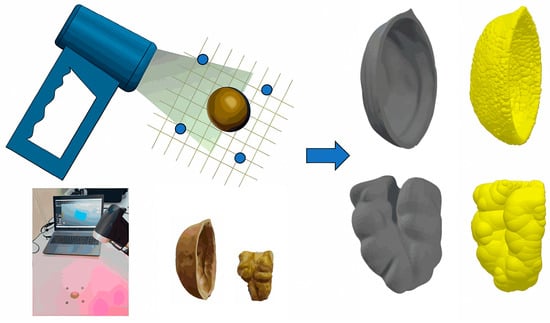
Figure 1.
Particle geometry acquisition and modeling. The gray model is the scanned STL model of the shell and kernel, while the yellow one represents the Discrete Element Method (DEM) model after particle filling.
2.1.2. Geometry Model
To achieve the separation of 1/2 shell and 1/8 kernel, the tooth slots of the toothed vibrating screen are designed with reference to the dimensions of 1/8 kernel and 1/2 shell. This design allows the kernel to more easily fall into the tooth slots, while the shell is blocked outside the slots. At the same time, it ensures that the 1/8 kernel moves upward step by step with the vibration on the toothed vibrating screen surface with a certain inclination angle. Due to the significant size difference and smooth surface, the 1/2 shell tends to move downward during vibration, thereby achieving the separation of the 1/2 shell and the 1/8 kernel. Regarding the parameters of the sawtooth screen, the size of the screen surface is set according to the actual effective working area. The specific dimensions and simple model are shown in Figure 2. The parameter characteristics and other contact coefficients of the geometric model in the simulation are shown in Table 2 and Table 3, respectively. These parameters are also obtained based on previous literature and experiments [18,23,26,27,28].
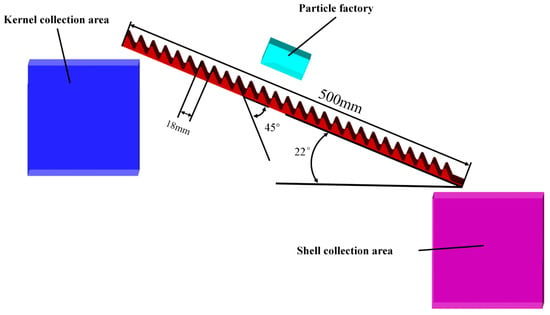
Figure 2.
Toothed vibrating screen model.

Table 2.
Physical properties parameters of walnut shell and kernel particles.

Table 3.
Contact coefficient between granules and geometric bodies.
2.2. Selection of Particle Contact Model
To simulate the movement and forces on walnut kernels on a vibrating screen, a soft-sphere model based on the three-dimensional commercial DEM software package (EDEM, DEM Solutions Ltd., Edinburgh, UK) was used. A model of dried walnut kernels was chosen, assuming no cohesive forces or liquid bridges between the walnut kernels [29]. Previous studies [30,31,32] have used the Hertz–Mindlin contact model to describe contact between particles or between particles and surfaces, so this model is adopted here. In this model, each particle exhibits translational and rotational motion, which can be described by Newton’s second law of motion, as follows:
where vi and ωi are the translational and angular velocities of grain i, respectively; mi and Ii are the mass and moment of inertia, respectively; ni is the number of grain j in contact with grain i; Fn is the normal contact force; and is the normal damping force. Similarly, Ft is the tangential contact force and is the tangential damping force. Tt is the torque caused by the tangential force and Tr is the rolling friction torque.
2.3. Simulation Conditions
This study exclusively simulates the 1/2 shell and 1/8 kernel. Based on actual production conditions, a feed rate of 40 g/s was found to be efficient; therefore, an equal mass of 1/2 shell and 1/8 kernel is generated, resulting in an output rate of 20 g/s each. To ensure uniform mixing of walnut shell and kernel materials, a particle factory was set up as a virtual cube with dimensions of 100 mm × 50 mm × 260 mm, generating both 1/2 shell and 1/8 kernel materials. A hollow box with dimensions of 700 mm × 500 mm × 280 mm was established as the calculation domain. The calculation domain mainly includes a walnut shell and kernel collection box and a toothed vibrating screen. The size of the walnut shell and kernel collection box is 150 mm × 150 mm × 280 mm. Due to the varying sizes of walnuts, which follow a normal distribution trend, the model size was set to fluctuate between 0.85 and 1.15 times. The vibration direction angle was set to 45°, the amplitude to 6.8 mm, the vibration frequency to 12 Hz, and the screen surface inclination angle was set to 16~26°, with each 2° serving as a group for simulation [33]. In EDEM, the fixed time step was set to 20% of the Rayleigh Time, and the position, velocity, contact, and collision of particles were automatically recorded every 0.01 s for a simulation time of 20 s. As shown in Figure 3, a random screenshot illustrates the separation simulation process of the 1/2 shell and 1/8 kernel.
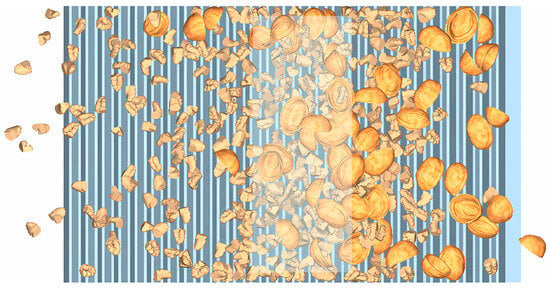
Figure 3.
Separation simulation process snapshot.
2.4. Angle of Repose Experiment
To verify the accuracy of the numerical model and with reference to previous studies, this paper uses a piling angle test to validate the physical property parameters and contact coefficients between materials in the simulation [34,35,36]. The piling test in a cylindrical container is typically set according to the maximum particle size of the material, requiring the cylinder diameter to be 4–5 times the maximum particle diameter and the cylinder height to be 3 times the cylinder diameter [37]. In the simulation, there are only two types of materials: 1/2 shell and 1/8 kernel. Therefore, based on the long axis of the walnut shell (with a maximum size of 38.3 mm), the cylinder diameter is set to 160 mm and the height to 480 mm. In the particle factory, a mixture of walnut shells and kernels is generated at a mass ratio of 1:1, filling 80% of the cylinder volume. After the generation of 1/2 shell and 1/8 kernel particles, the system is left to rest for 2 s to reach a stable state before the cylinder is lifted vertically. Studies have shown that the lifting speed of the cylinder affects the formation of the particle pile [38]. Therefore, in this paper, the cylinder is lifted at a speed of 0.05 m/s until all material has been released from the cylinder and the particle pile is in a static state. Figure 4 shows the simulation test process and the verification test equipment and process.
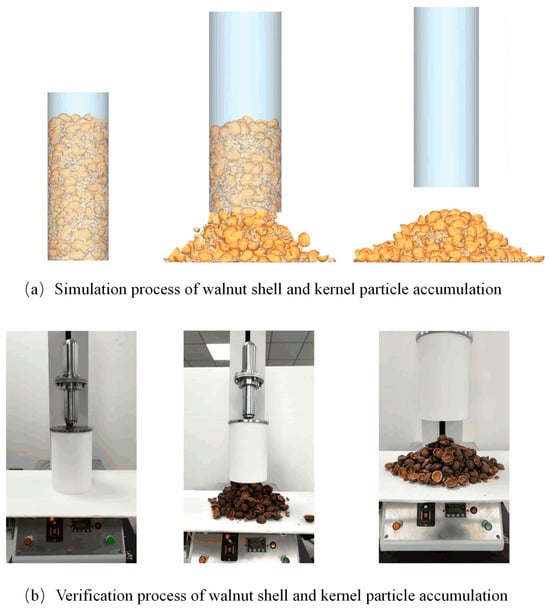
Figure 4.
Simulation experiment and verification process of stacking angle.
2.5. Experimental Verification Under Operational Conditions
To ensure that the established model can accurately simulate the screening process under the corresponding working conditions, this paper conducted validation under actual conditions. Figure 5 shows the validation test platform. First, the operational parameters of the toothed vibrating screen shell and kernel separation test platform were adjusted to match those of the simulation (the screen surface inclination angle was set to 22°, the vibration frequency to 12 Hz, and the amplitude to 7 mm). The feed rate was set to 20 g/s for both walnut shells and kernels. After stabilizing the operation, the separation situation of the walnut shells and kernels was statistically analyzed.

Figure 5.
Toothed vibrating screen walnut kernel separation test bench. 1. Feed plate; 2. Frame; 3. Oscillating arm; 4. Pulley;5. Belt 6. Motor; 7. Variable frequency drive; 8. Eccentric wheel; 9. Walnut kernel outlet; 10. Vibrating screen frame; 11. Toothed vibrating screen.
3. Results
3.1. Model Validation
Using MATLAB R2020asoftware for image recognition of walnut shell kernel particle piles, the images of walnut shell kernel particle piles undergo processes such as grayscaling, binarization, and threshold segmentation to obtain accurate contour lines of the walnut shell kernel particle piles. MATLAB software is used to extract the single-sided boundary contour of the angle of repose [39,40], and the least squares method is used to fit a linear function and obtain the slope of the straight line. Finally, the angle of repose of the walnut shell kernel particle pile is calculated. The specific operation process is as follows:
- Observe the stabilized walnut shell kernel particle pile from the side view direction and grayscale the walnut shell kernel particle pile. Due to the slight difference in the horizontal angles of the two sides, choose the smoother and more regular side as the contour for calculating the angle of repose; in this paper, the left contour line is selected.
- Perform binarization processing on the left contour image of the walnut shell kernel particle pile and find the contour pixel points of the walnut shell kernel particle pile, ultimately obtaining the boundary contour line of the walnut shell kernel particle pile. For simulated walnut shell kernel particle piles, this information can be directly obtained by setting the color of all particles to black, thus directly obtaining a clear image of the grayscaled walnut shell kernel particle pile.
- Finally, fit the left boundary contour line of the walnut shell kernel particle pile to obtain the linear function fitting equation, and then derive the angle of repose of the walnut shell kernel particle pile through Equation (3).
After five experiments, the final physical angle of repose for walnut shells was obtained as 29.7°, while the simulated angle of repose was 31.5°, as shown in Figure 6. The error between the two is small, proving that this parameter is reliable and can be used for subsequent simulation experiments.
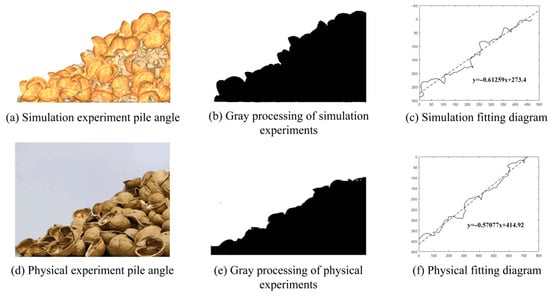
Figure 6.
Calculation process of the stacking angle of walnut shells and kernels. The solid and dashed lines in (c) and (f) are the material stacking contours and their fitted lines, respectively.
3.2. Results from the Operational Verification Test
Figure 7 is an instantaneous snapshot of the actual screening process. Compared to Figure 3, it can be observed that the overall distribution of materials on the screen surface is basically consistent, which preliminarily indicates that the simulation is quite accurate. To further verify the simulation accuracy, the moment when the material starts to discharge from the outlet is taken as time zero, and a statistical time interval of 2 s is used to record the mass of material discharged from the outlet over time [41,42,43], as shown in Figure 8.

Figure 7.
Schematic diagram of bench verification test.
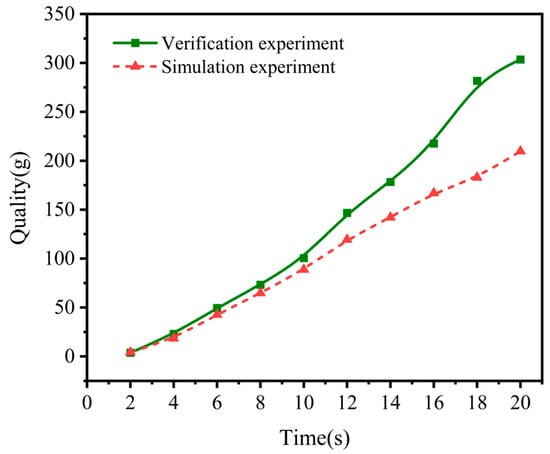
Figure 8.
Comparison chart of validation experiment and simulation experiment.
Based on Figure 8, both curves exhibit an increasing trend and demonstrate close agreement within the 0–10 s interval. Beyond 10 s, while maintaining a consistent overall trend, a deviation in discharge mass is observed. This discrepancy primarily arises from inherent variations in manual feeding that are challenging to replicate identically in the simulation. To rigorously assess whether significant differences exist between the numerical simulation and experimental validation, a one-way analysis of variance (ANOVA) was performed, with the results presented in Table 4. The ANOVA indicates that p > 0.05, demonstrating no statistically significant difference between the experimental and simulation results. Therefore, employing the Discrete Element Method (DEM) numerical simulation to investigate the kinematic behavior of walnut shell–kernel mixtures on the toothed-vibrating screen represents a feasible approach.

Table 4.
Variance analysis of material quality at the outlet.
3.3. Principle of Walnut Shell Kernel Screening
To demonstrate that this method can effectively achieve the separation of 1/2 shell and 1/8 kernel, the feasibility of the approach was analyzed through theoretical and simulation analysis. As shown in Figure 9, a schematic diagram of the force analysis on the walnut shell and kernel on the screen surface is presented. Taking the upward direction along the screen plate as positive, we analyze the forces acting on the walnut shell when it is in the critical state of sliding. At this point, the force situation acting on the walnut shell is as follows:
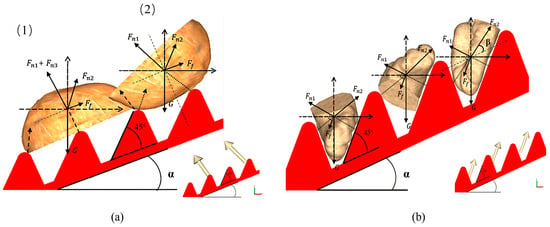
Figure 9.
Analysis of forces on walnut shell and kernel and vector diagram. (a) Stress analysis and vector diagram of walnut shell on the sieve surface. (1) and (2) respectively represent the two postures of walnut shells on the sieve surface. (b) Stress analysis and vector diagram of walnut kernels on the sieve surface.
Equation (4) corresponds to situation (1) in Figure 9a, while (Equation (5)) corresponds to situation (2) in the figure.
The stress condition of walnut kernels is as follows:
From Equation (6), it can be seen that the force acting on the walnut shell material on the inclined screen plate is primarily influenced by the inclination angle α of the screen surface, the tooth angle, and the support angle β. Given that the tooth angle is fixed at 45°, and the support angle β is affected by the shape of the material itself, it can be concluded that the inclination angle of the screen surface is a key factor influencing the force on the material on the screen plate.
Combining the vector diagrams from the bottom-right corners of Figure 9a,b. it can be observed that when the walnut shell kernel moves on the sieve surface, the resultant force in the Y-axis direction causes the walnut shell kernel to bounce, while the resultant force in the X-axis direction is the primary reason for the separation of the walnut shell kernels. The opposing resultant forces in the X-axis direction promote the relative motion of the walnut shell kernels on the vibrating sawtooth sieve, facilitating their separation.
Figure 10 shows the motion trajectory of walnut shells and kernels on a toothed vibrating screen and the force conditions when they contact the screen surface. One half-shell and one eighth-kernel were randomly selected from the simulation, and their motion processes at six moments on the toothed vibrating screen were marked. The half-shell was generated at 0.2 s and completed separation at 1 s, marked as moments 1–6; the eighth-kernel was generated at 0.4 s and completed separation at 3 s, marked as moments 7–12. The force conditions of the walnut shells and kernels when contacting the screen surface at the corresponding moments were extracted. As shown in Figure 10, the walnut shell collides with the toothed vibrating screen at moment 1, receiving a resultant force to the right, causing the walnut shell to rotate and contact the zigzag screen with its convex surface. Subsequently, at moments 2–4, the walnut shell continuously receives resultant forces to the left, causing it to move leftward. At around moment 5, it collides violently with the zigzag screen, causing the walnut shell to bounce up and then fall into the shell outlet to complete separation. The walnut kernel collides with the screen surface at moment 7 and falls into the tooth slot. Subsequently, from moments 8–12, the reciprocating vibration of the zigzag screen causes the kernel to “climb the screen” and move upward step by step, eventually achieving separation. In summary, the reason for the separation of walnut shells and kernels on the screen surface can be deduced. The eighth-kernel on the toothed vibrating screen is more likely to fall into the tooth slot and move upward step by step with the reciprocating vibration. In contrast, the half-shell, due to the significant difference in size from the tooth slot and its smooth surface, gradually moves downward with the reciprocating vibration. This conclusion is consistent with the force analysis in the previous text, further proving that this method can effectively achieve the separation of half-shells and eighth-kernels.
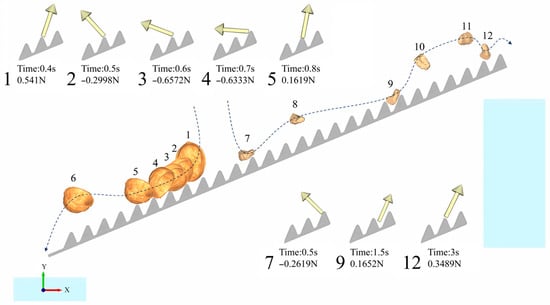
Figure 10.
The movement process of walnut shells and walnut kernels on the toothed vibrating screen and the force situation in the X-axis direction. Panels 1–12 depict the motion state of the material on the screen surface at a given moment. The vector arrows on both sides of the images represent the corresponding force (direction and magnitude) acting on the material at that same moment.
In summary, among the many factors affecting the direction and magnitude of the resultant force on the material on the screen surface, the role of the screen surface inclination angle is more critical and direct compared to amplitude and frequency. Therefore, in order to improve the screening efficiency, the following discussion will explore the influence of the inclination angle on the screening effect, with the screen surface inclination angle as the key factor.
3.4. The Effect of Screen Inclination Angle on the Sorting Efficiency of Walnut Shells and Kernels
Figure 11 illustrates the influence of the screen surface inclination angle on the cleaning rate and loss rate during the separation of walnut shells and kernels. As the angle increases, both rates exhibit an overall upward trend. However, their changing patterns are significantly different: the cleaning rate increases monotonically and consistently, while the loss rate rises slowly between 16° and 22° but experiences a sharp increase after a turning point at 22°. At this 22° inclination, the loss rate remains below 10%, and the cleaning rate reaches a maximum exceeding 95%, representing the best overall separation performance among the tested angles.
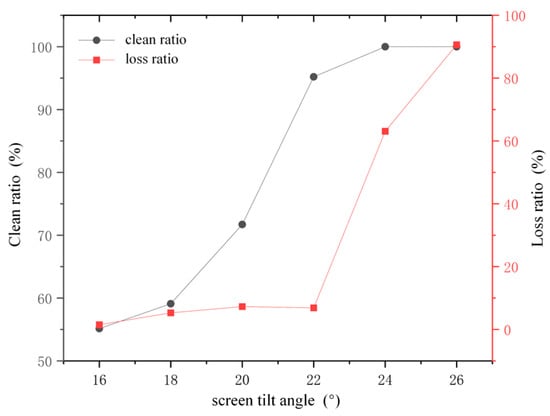
Figure 11.
The influence of the screen tilt angle on the clean rate and loss rate.
These trends are governed by the distinct movement mechanisms of shells and kernels. The continuous increase in the cleaning rate is primarily because the larger 1/2 shells contacting the raised screen surface experience reduced friction and an increased component of gravity parallel to the screen as the inclination grows. This accelerates the downward movement of the shells. Even shells temporarily obstructed by the grooves become destabilized due to the increased parallel gravitational component and eventually vibrate across the grooves into the shell outlet. The sharp increase in the loss rate at 22° is related to the decreased stability of the 1/8 kernels within the tooth grooves. When the inclination reaches this critical angle, the thrust provided by the screen not only propels the kernels upwards but also easily ejects those not fully embedded in the grooves. These ejected kernels have a significantly higher probability of moving toward the shell outlet under gravity, causing the loss rate to surge.
Therefore, relying solely on the adjustment of the screen inclination cannot achieve both a high cleaning rate and a low loss rate. Although the 22° inclination provides the optimal compromise, the persisting ~10% loss rate indicates that factors beyond the inclination angle contribute to shell retention and kernel loss. Consequently, the retention and loss mechanisms of the 1/2 shells and 1/8 kernels will be investigated next to further improve the separation efficiency of the toothed vibrating screen.
3.5. Analysis of the Retention and Loss Mechanisms of Walnut Shells and Kernels
As shown in Figure 11, a screen surface inclination of 22° yields the optimal screening performance under current conditions. Therefore, to eliminate the influence of the angle factor, all subsequent analyses are based on this inclination unless otherwise specified. The separation process of walnut shells and kernels, simulated via EDEM, is presented in Figure 12. To facilitate further analysis, the screen surface is divided into functional zones based on the distribution and movement patterns of the materials: the walnut kernel conveying area (blue dashed box), the walnut shell conveying area (red dashed box), and the separation area (yellow dashed box). It can be observed that separation within the designated area is incomplete, with some shells and kernels appearing in their non-target conveying areas. This indicates that simply adjusting the inclination angle cannot achieve complete separation. Clarifying the mechanisms of kernel loss and shell retention is thus critical to improving the separation efficiency. The following sections will elucidate these phenomena by analyzing variations in movement patterns, the collision process between materials, and the associated forces.

Figure 12.
Phenomenon of walnut kernel retention and loss in simulation experiments.
3.5.1. Analysis of the Mechanism of Walnut Kernel Loss
Figure 13 illustrates the trajectories of two representative walnut kernel particles (Particle 1 and 2, generated at t = 9.05 s) to elucidate the loss mechanism. The observed outcomes were divergent: Particle 1 reached the kernel outlet, while Particle 2 was lost to the shell outlet. Analysis of their paths reveals that Particle 2 experienced multiple collisions with the screen and the shell bed, which redirected it into the walnut shell transport area. This journey was characterized by three significant collision-induced displacements at 10.1 s, 12.0 s, and 12.7 s. In contrast, Particle 1 entered the kernel transport area directly after landing, encountering minimal shell interaction. These observations demonstrate that collisions with walnut shells are critical to the loss mechanism. They not only prevent kernels from entering the correct transport area but also actively carry them into the shell collection zone, leading to loss.
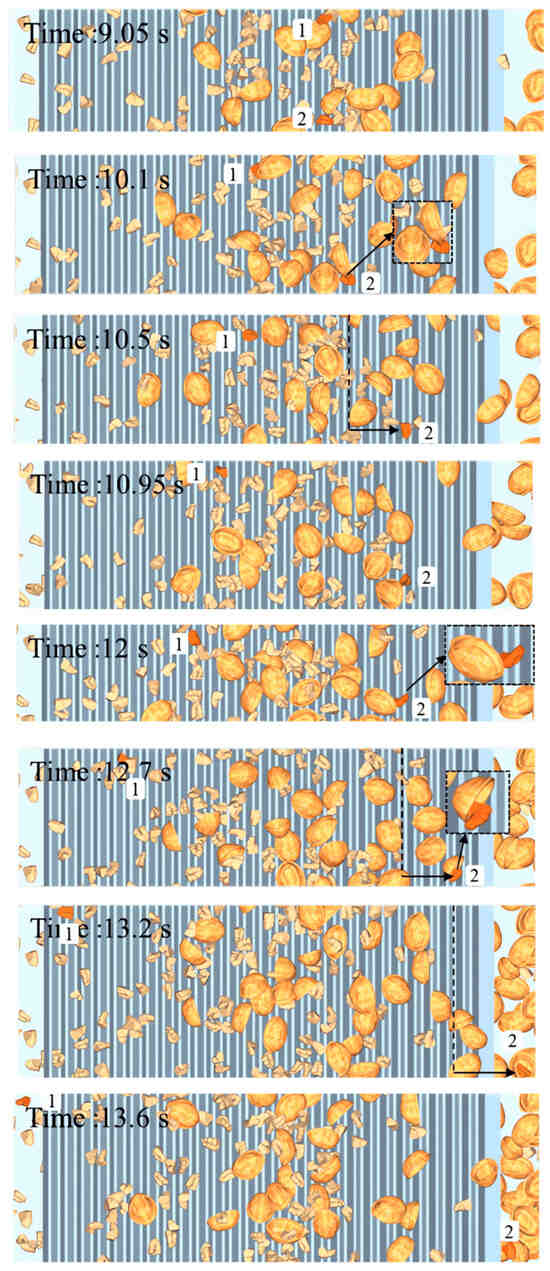
Figure 13.
Motion of the two typical walnut kernel particles (Particle 1 and 2) on the screen surface.
To further validate the mechanism of kernel loss, the velocity of a representative kernel (Particle 2) in the X-direction was analyzed (Figure 14). Particle 2 ultimately reported to the shell collection box (negative X-direction), resulting in kernel loss. Three distinct velocity minima were identified at 10.2 s, 12.2 s, and 13.1 s, each signifying a strong collision that reversed the particle’s direction. These minima correspond to the time intervals of 9.9–10.2 s, 12.0–12.2 s, and 12.7–13.1 s. A direct comparison with the snapshots in Figure 13 confirms that these intervals align with three major collision events experienced by Particle 2 on the screen surface. This correlation conclusively demonstrates that kernel-shell collisions are a primary driver of kernel loss.
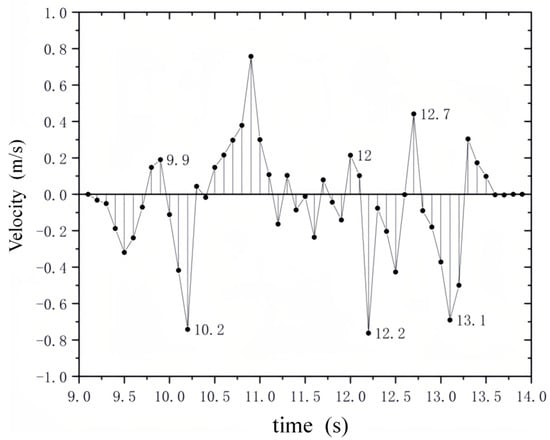
Figure 14.
Velocity variation of particle 2 on the X-axis of the sieve surface.
3.5.2. Analysis of the Mechanism of Walnut Shell Retention
Figure 15 traces the trajectory of a retained walnut shell particle, visually documenting its unintended transport into the walnut kernel collection box. A detailed analysis of its motion and the corresponding force conditions reveals that shell retention is primarily driven by two distinct collision mechanisms. These forces manifest through two characteristic collision types: “Thrust Collision” refers to the force exerted on the walnut shell by the screen surface along the X-axis (parallel to the screen surface) when the shell contacts 2–3 tooth surfaces during its upward movement phase. This force acts opposite to the component of gravity, propelling the shell upward against gravity. As this force originates directly from the screen vibration, its frequency corresponds to the vibration frequency of the equipment. “Enveloping Collision” occurs when the walnut shell is continuously and multi-directionally impacted by surrounding walnut kernels in the separation area, resulting in the shell being “encapsulated” and collectively pushed upward. This type of collision is identified when the resultant force from kernel impacts on the shell in the X-axis direction exceeds the component of the shell’s gravity in the same direction.

Figure 15.
Transport process of retained walnut shells on the screen surface (a–f).
The retention process, as evidenced in Figure 15, is sequential. After initial interference at 4.95 s, the shell enters the kernel conveying area. From stages Figure 15b to Figure 15f, it is caught in an “enveloping collision” stage, where it is fully surrounded by kernels and carried upward by their collective motion. As the mixture ascends and disperses, the dense packing destabilizes. From stages Figure 15f to Figure 15h, the “thrust collision” stage becomes dominant; direct, sustained impacts with the screen teeth break the envelopment and provide the final thrust needed to push the shell into the kernel collection area.
In summary, shell retention is a phased process initiated by collective “enveloping collision” in the dense separation bed and completed by direct “thrust collision” with the screen surface as the particle assembly thins out. This mechanistic understanding confirms that kernel-shell interactions and screen kinematics jointly govern the unintended upward transport of shells.
To further demonstrate the mechanism of the retained walnut shell and the effect of different collisions on it, the collision force between the retained walnut shell and the walnut kernel during the separation process was extracted, as shown in Figure 16. As can be seen from Figure 16, the retained walnut shell consistently collides with the walnut kernel before 7.1 s, and the uninterrupted collision force indicates that the retained walnut shell is in the “enveloping collision” stage within the period of 4.95 s to 7.1 s. The snapshot above shows that when the collision force is relatively large, the retained walnut shell collides with multiple walnut kernels. Around 5.7 s in the figure, the collision force is smaller but still in the “enveloping collision” stage. Through the analysis of the simulation process, it was found that the walnut shell simultaneously collides with both walnut kernels and walnut shell kernels, with the collision force between two walnut shells being the main collision force at this time.
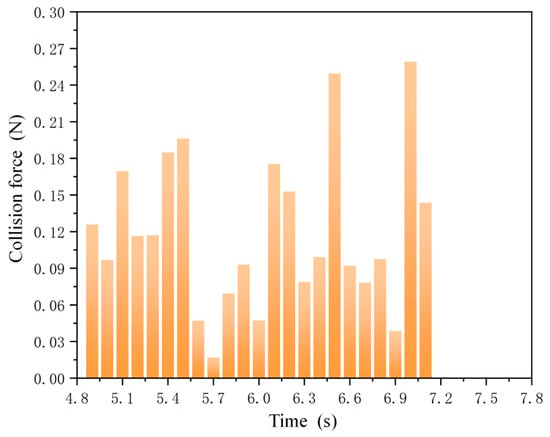
Figure 16.
Time history of the collision force on a typical walnut shell.
To validate the universality of the aforementioned viewpoint, we conducted statistics on the retention duration and collision frequency of six retained walnut shells during the simulation process, as shown in Figure 17. From Figure 17a, it can be observed that the collision frequency is positively correlated with the retention duration. Among the six retained walnut shells, the shortest retention time is 2.85 s for the first shell, and the longest retention time is 10.6 s for the sixth shell. In terms of collision frequency, the first shell has the fewest collisions with 458 times, while the sixth shell has the most with 2619 times. From Figure 17b, it can be seen that collisions between the shell and the kernel account for 51.8% of the total collisions in the composition of collisions for the retained shells. These results are consistent with the findings in Figure 15 and Figure 16, further proving that the “enveloping collision” between the shell and the kernel is the main reason for their retention.
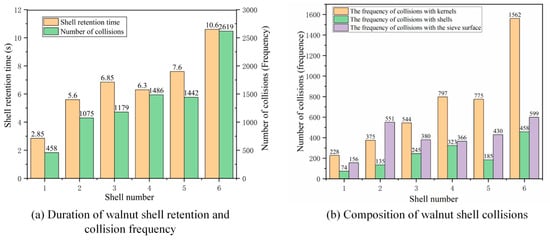
Figure 17.
Retention and collision situations of six representative walnut shells.
Based on the above research, it has been demonstrated that the mechanism for walnut shell retention and walnut kernel loss is due to the excessive concentration of walnut shell and kernel in the separation area, and the incomplete separation under the action of “enveloping collision” leading to their entry into respective transport areas and resulting in intense collisions that ultimately cause losses. The loss of walnut kernels mainly includes two types: continuous downward loss and alternating upward and downward loss. The retention process of walnut shells generally includes two stages: “enveloping collision” and “thrust collision”.
Based on the revealed mechanisms of shell retention and kernel loss, future research will focus on reducing shell–kernel collisions to further improve separation efficiency. This study has established the fundamental relationship between macroscopic collision phenomena and separation outcomes, providing a solid basis for subsequent investigations. Building on these findings, further work will systematically examine the mechanical principles of thrust and enveloping collisions through optimized screen configurations and process innovations. Specific approaches will include modifying tooth groove geometry to guide material transport, developing specialized screen surface profiles, and implementing air-assisted systems for material dispersion. These technological improvements are expected to effectively minimize collision frequency and intensity, thereby significantly enhancing separation performance.
4. Conclusions
This study employed EDEM simulation to analyze the separation process of a mixture of 1/2 shell and 1/8 kernel on screens with different inclinations. By tracking the motion, collisions, and forces acting on the materials, we elucidated the separation mechanism on the toothed vibrating screen. This analysis further revealed the underlying mechanisms responsible for walnut kernel loss and shell retention. The main conclusions of the study are as follows:
- With the increase in the screen surface inclination, both the cleaning rate and the loss rate show an upward trend. However, the cleaning rate gradually increases with the increase in the screen surface inclination, while the loss rate remains stable at first and then shows a turning point at 22°, where it rapidly increases. Within the optimal range of screen surface inclination, the inclination has a significant impact on the separation effect of walnut shells and kernels, but adjusting the screen surface inclination alone cannot achieve complete separation of walnut shells and kernels.
- During the separation on the toothed vibrating screen, the toothed vibrating screen is designed according to the size of the 1/8 kernel, making it easier to fall into the toothed grooves and be pushed upward step by step. In contrast, the size of the 1/2 shell differs significantly from the toothed vibrating screen, and its smoother surface makes it unable to effectively receive the thrust needed for “over-screening,” causing it to slip down to the shell outlet.
- The loss of kernels and retention of shells are primarily caused by the excessive concentration of the mixture in the separation area. This high concentration prevents complete separation due to “enveloping collisions”. Consequently, intense collisions occur in the respective transport areas, ultimately leading to loss. Specifically, kernel loss manifests as either continuous downward loss or alternating upward and downward loss. Meanwhile, the retention process of walnut shells involves two distinct stages: “enveloping collision” followed by “thrust collision”.
Author Contributions
Resources, H.Z. and W.Z.; methodology, P.C.; writing—original draft preparation, Y.Z. and P.C.; writing—review and editing, C.W. and Y.Z.; data curation, Z.L. and C.W.; visualization, C.W. and G.G.; supervision, P.C. and Y.Z.; funding acquisition, Y.Z. and J.M. All authors have read and agreed to the published version of the manuscript.
Funding
This work has received support from National Natural Science Foundation of China-Xinjiang Joint Fund (12462017, 12002229), Major Innovation Project of the National Forestry and Grassland Equipment Science and Technology Innovation Park (2024YG06), Tarim University President Fund Project (TDZKBS202414), and Key R&D Program Projects of Xinjiang Uygur Autonomous Region (2024B02017).
Institutional Review Board Statement
Not applicable.
Informed Consent Statement
Not applicable.
Data Availability Statement
The data presented in this study are available on request from the corresponding author.
Acknowledgments
The authors are grateful to the anonymous reviewers for their comments.
Conflicts of Interest
The authors declare no conflicts of interest.
Nomenclature
| Vi | Translational velocity, m·s−1 |
| ωk | Angular velocity, rad·s−1 |
| mi | Quality, N |
| Ii | Moment of inertia, Kg·m2 |
| ni | The number of contacts between the walnut shell i and the walnut kernel j |
| Fn | Normal Contact Force, N |
| Normal Damping Force, N·m·s−1 | |
| Tangential contact force, N | |
| Tangential damping force, N·m·s−1 | |
| Tangential Force Moment, N·m | |
| Rolling Friction Torque, N·m | |
| G | Gravity, N |
| Ff | Friction, N |
References
- Panasiewicz, M.; Mazur, J.; Zawiślak, K.; Kulig, R.; Łysiak, G. The Process of Separation of Husked Soybean in Oblique Airflow. Sustainability 2020, 12, 7566. [Google Scholar] [CrossRef]
- Shin, S.-Y.; Kim, M.-H.; Cho, Y.; Kim, D.-C. CFD Analysis and Validation of a Foreign Material Winnowing Machine for Pepper Harvester. Appl. Sci. 2022, 12, 6134. [Google Scholar] [CrossRef]
- Ma, X.; Zhao, L.; Guo, B.; Dang, H. Simulation and Experiment of Rice Cleaning in Air-Separation Device Based on DEM-CFD Coupling Method. Int. J. Agric. Biol. Eng. 2020, 13, 226–233. [Google Scholar] [CrossRef]
- Qu, S.; Zhu, Z.; Mao, W. Research on aerodynamic characteristics of walnut materials and optimization of shell-kernel air separation device. China Oils Fats. 2024, 49, 145–152. [Google Scholar] [CrossRef]
- Li, H.; Tang, Y.; Zhang, H.; Liu, Y.; Zhang, Y.; Niu, H. Technological Parameter Optimization for Walnut Shell-Kernel Winnowing Device Based on Neural Network. Front. Bioeng. Biotechnol. 2023, 11, 1107836. [Google Scholar] [CrossRef]
- Khir, R.; Pan, Z.; Atungulu, G.G.; Thompson, J.F. Characterization of Physical and Aerodynamic Properties of Walnuts. Trans. ASABE 2014, 57, 53–61. [Google Scholar] [CrossRef]
- Zhang, H.; Liu, H.; Zeng, Y.; Tang, Y.; Zhang, Z.; Che, J. Design and Performance Evaluation of a Multi-Point Extrusion Walnut Cracking Device. Agriculture 2022, 12, 1494. [Google Scholar] [CrossRef]
- Li, J.; Shen, Y.; Zhao, Y. Test and computer simulation on the motion of agricultural materials on agitated conveying board. Trans. Chin. Soc. Agric. Mach 1998, 14, 213–216. [Google Scholar]
- Wang, J.; Liao, M.; Xia, H.; Chen, R.; Li, J.; Yang, Y. Study on the Conveying Characteristics of a Hanged Harvester Vibrating Screen for Ligusticum Chuanxiong. Processes 2024, 12, 1323. [Google Scholar] [CrossRef]
- Wang, L.; Liu, W.; Li, Y.; Yu, K. Research on double-layer jitter plates with holes in large-feeding mass cleaning system of maize grain harvester. Trans. Chin. Soc. Agric. Mach. 2022, 53, 92–102. [Google Scholar] [CrossRef]
- Wang, Y.; Liang, Z.; Liu, Z.; Niu, W.; Yi, S. Selection of parameters and experiment of one-way inclining gravity screen for 5XFZ-30.0 model gravity cleaner. Trans. Chin. Soc. Agric. Eng. 2004, 20, 115–119. [Google Scholar] [CrossRef]
- Fu, W.; Yang, L.; He, R.; Zhang, H.; Kan, Z. Analysis and improvement of oscillating plate of grain combine harvester. Shihezi Univ. Nat. Sci. 2012, 30, 249–251. [Google Scholar] [CrossRef]
- Tang, Q.; Wu, C.; Wu, D.; Mu, S.; Liang, S. Study on the performance of jitter plate of grain combine harvester based on DEM. Jiangsu Agric. Sci. 2017, 45, 208–210. [Google Scholar] [CrossRef]
- Li, H.; Li, Y.; Tang, Z. Numerical simulation of material motion on vibrating screen of air-and-screen cleaning device based on CFD-DEM. Trans. Chin. Soc. Agric. Mach. 2012, 43, 79–84. [Google Scholar] [CrossRef]
- Wang, L.; Chai, J.; Wang, H.; Wang, Y. Design and Performance of a Countersunk Screen in a Maize Cleaning Device. Biosyst. Eng. 2021, 209, 300–314. [Google Scholar] [CrossRef]
- Zhang, H.; Zhou, Z.; Qu, Z.; Li, Z.; Wang, W. Simulation and Experiment of Sieving Process of Sieving Device for Tiger Nut Harvester. Agriculture 2022, 12, 1680. [Google Scholar] [CrossRef]
- Guan, R.; Gu, J.; Li, Y.; Yang, C.; Zhang, B.; Yao, X.; Zhu, R.; Wang, Q.; Dong, W.; Huang, Y. Simulation and Experimental Study of Shell-Kernel Separation Device for Household Sunflower Based on CFD-DEM Coupling. Sci. Rep. 2025, 15, 9209. [Google Scholar] [CrossRef] [PubMed]
- Li, H.; Niu, H.; Zhang, H.; Zhang, M. Performance Evaluation and Parameter Optimization of a Walnut Shell–Kernel Winnowing Device. J. Food Process Eng. 2024, 47, e14498. [Google Scholar] [CrossRef]
- Zhang, X.; Ke, Y.; Sun, P.; Xu, Y.; Chen, C. Study on the separation particle size of ellipsoidal particle linear vibration sieve based on EDEM. Jiangsu Agric. Sci. 2018, 46, 188–191. [Google Scholar] [CrossRef]
- Liu, X.; Wang, W.; Song, S. Simulation analysis of the influencing parameters of the rice screening performance of the experimental vibrating screen based on EDEM. Cereals Oils 2025, 38, 142–148. [Google Scholar] [CrossRef]
- Gao, Y.; Song, L.; Wang, L.; Wang, H.; Li, Y. Behavior of Maize Grains on the Three-Dimensional Translational Vibrating Sieve. Powder Technol. 2022, 412, 117999. [Google Scholar] [CrossRef]
- Feng, X.; Gong, Z.; Wang, L.; Yu, Y.; Liu, T.; Song, L. Behavior of Maize Particle Penetrating a Sieve Hole Based on the Particle Centroid in an Air-Screen Cleaning Unit. Powder Technol. 2021, 385, 501–516. [Google Scholar] [CrossRef]
- Hu, G.; Chen, X.; Zhao, T.; Dong, Y.; Liu, G.; Zhou, J. Optimization of grading process of walnut shell and kernel mixture by vibrating screen based on EDEM. China Oils Fats 2024, 49, 95–100. [Google Scholar] [CrossRef]
- Jiang, Y.; Tang, Y.; Li, W.; Zeng, Y.; Li, X.; Liu, Y.; Zhang, H. Determination Method of Core Parameters for the Mechanical Classification Simulation of Thin-Skinned Walnuts. Agriculture 2022, 13, 104. [Google Scholar] [CrossRef]
- Man, X.; Li, L.; Zeng, Y.; Tang, Y.; Yang, J.; Fan, X.; Zhang, Y.; Zhang, H.; Su, G.; Wang, J. Mechanical Impact Characteristics of Hollow Shell Granule Based on Continuous Damage Theory. Powder Technol. 2023, 429, 118946. [Google Scholar] [CrossRef]
- Chen, X.; Hu, G.; Zhao, T.; Li, Z.; Zhou, J. Simulation Study on Negative Pressure Winnowing of Walnut Kernel Mixture Based on CFD-DEM Coupling. Shandong Agric. Univ. Nat. Sci. 2021, 52, 1017–1027. [Google Scholar]
- Chen, P.; Han, Y.; Jia, F.; Meng, X.; Xiao, Y.; Bai, S. DEM Simulations and Experiments Investigating the Influence of Feeding Plate Angle in a Rubber-Roll Paddy Grain Huller. Biosyst. Eng. 2021, 201, 23–41. [Google Scholar] [CrossRef]
- Cao, C.; Luo, K.; Peng, M.; Wu, Z.; Liu, G.; Li, Z. Experiment on Winnowing Mechanism and Winnowing Performance of Hickory Material. Trans. Chin. Soc. Agric. Mach. 2019, 50, 105–112. [Google Scholar] [CrossRef]
- Han, Y.; Jia, F.; Zeng, Y.; Jiang, L.; Zhang, Y.; Cao, B. Effects of Rotation Speed and Outlet Opening on Particle Flow in a Vertical Rice Mill. Powder Technol. 2016, 297, 153–164. [Google Scholar] [CrossRef]
- Han, Y.; Jia, F.; Zeng, Y.; Jiang, L.; Zhang, Y.; Cao, B. DEM Study of Particle Conveying in a Feed Screw Section of Vertical Rice Mill. Powder Technol. 2017, 311, 213–225. [Google Scholar] [CrossRef]
- Zeng, Y.; Jia, F.; Xiao, Y.; Han, Y.; Meng, X. Discrete Element Method Modelling of Impact Breakage of Ellipsoidal Agglomerate. Powder Technol. 2019, 346, 57–69. [Google Scholar] [CrossRef]
- Cao, B.; Jia, F.; Zeng, Y.; Han, Y.; Meng, X.; Xiao, Y. Effects of Rotation Speed and Rice Sieve Geometry on Turbulent Motion of Particles in a Vertical Rice Mill. Powder Technol. 2018, 325, 429–440. [Google Scholar] [CrossRef]
- Li, Z. Study on the Mechanism of Walnut Shell-Kernel Separation by Vibrating Sawtooth Sieve Type. Master’s Thesis, Tarim University, Xinjiang, China, 2024. [Google Scholar] [CrossRef]
- Han, Y.-L.; Jia, F.-G.; Tang, Y.-R.; Liu, Y.; Zhang, Q. Influence of Granular Coefficient of Rolling Friction on Accumulation Characteristics. Acta Phys. Sin. 2014, 63, 174501. [Google Scholar] [CrossRef]
- Coetzee, C.J.; Els, D.N.J. Calibration of Discrete Element Parameters and the Modelling of Silo Discharge and Bucket Filling. Comput. Electron. Agric. 2009, 65, 198–212. [Google Scholar] [CrossRef]
- Wei, H.; Tang, X.; Ge, Y.; Li, M.; Saxén, H.; Yu, Y. Numerical and Experimental Studies of the Effect of Iron Ore Particle Shape on Repose Angle and Porosity of a Heap. Powder Technol. 2019, 353, 526–534. [Google Scholar] [CrossRef]
- Jia, F.; Han, Y.; Liu, Y.; Cao, Y.; Shi, Y.; Yao, L.; Wang, H. Simulation prediction method of repose angle for rice particle materials. Trans. Chin. Soc. Agric. Eng. 2014, 30, 254–260. [Google Scholar] [CrossRef]
- Derakhshani, S.M.; Schott, D.L.; Lodewijks, G. Micro–Macro Properties of Quartz Sand: Experimental Investigation and DEM Simulation. Powder Technol. 2015, 269, 127–138. [Google Scholar] [CrossRef]
- Xia, R.; Li, B.; Wang, X.; Li, T.; Yang, Z. Measurement and Calibration of the Discrete Element Parameters of Wet Bulk Coal. Measurement 2019, 142, 84–95. [Google Scholar] [CrossRef]
- Zhao, L.; Zhou, H.; Xu, L.; Song, S.; Zhang, C.; Yu, Q. Parameter Calibration of Coconut Bran Substrate Simulation Model Based on Discrete Element and Response Surface Methodology. Powder Technol. 2022, 395, 183–194. [Google Scholar] [CrossRef]
- Chen, P.; Han, Y.; Jia, F.; Zhao, D.; Meng, X.; Li, A.; Chu, Y.; Zhao, H. Investigation of the Mechanism of Aerodynamic Separation of Rice Husks from Brown Rice Following Paddy Hulling by Coupled CFD-DEM. Biosyst. Eng. 2022, 218, 200–215. [Google Scholar] [CrossRef]
- Yang, J.; Zhang, W.; Gao, J.; Yao, Y.; Sun, C. Optimizing the Rap Sieving Efficiency on Linear Vibrating Sieve by Using Dem Simulation. SSRN Electron. J. 2021, 333, 127442. [Google Scholar] [CrossRef]
- Chen, P.; Jia, F.; Han, Y.; Meng, X.; Li, A.; Chu, Y.; Zhao, H. Study on the Segregation of Brown Rice and Rice Husks Mixture in Inclined Chute Flow. Powder Technol. 2022, 404, 117393. [Google Scholar] [CrossRef]
Disclaimer/Publisher’s Note: The statements, opinions and data contained in all publications are solely those of the individual author(s) and contributor(s) and not of MDPI and/or the editor(s). MDPI and/or the editor(s) disclaim responsibility for any injury to people or property resulting from any ideas, methods, instructions or products referred to in the content. |
© 2025 by the authors. Licensee MDPI, Basel, Switzerland. This article is an open access article distributed under the terms and conditions of the Creative Commons Attribution (CC BY) license (https://creativecommons.org/licenses/by/4.0/).